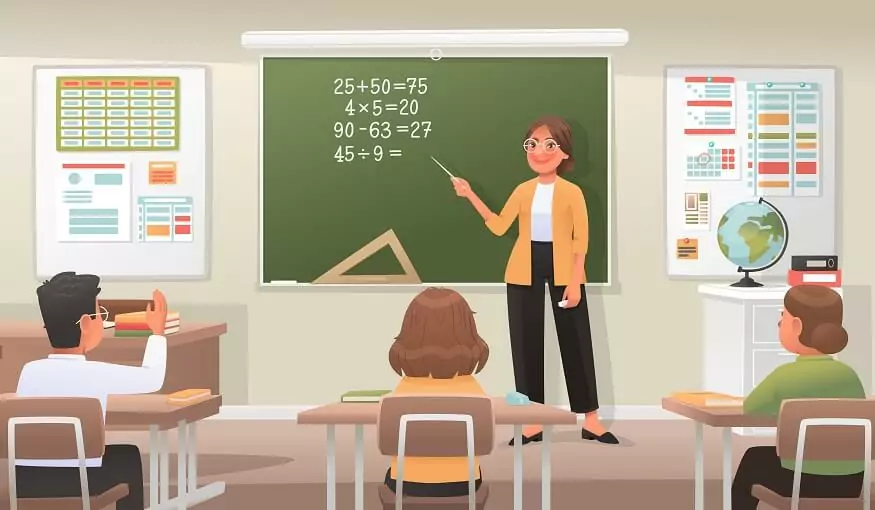I still remember my first week as a teacher about 13 years ago. I had meticulously planned engaging lessons, decorated my classroom with inspiring quotes, and was brimming with enthusiasm. Then reality hit. By Wednesday afternoon, my carefully crafted math lesson had devolved into chaos—two students were arguing loudly, several others were off-task and chatting, and one child was crawling under tables. I stood there, worksheet in hand, wondering where I had gone wrong and how I could possibly regain control.
That humbling experience taught me what many new teachers discover: content knowledge and lesson planning, while essential, aren’t enough. Effective teaching requires skillful classroom management. Over the years, through trial and error, mentorship, and professional development, I’ve developed approaches that transformed my classroom from chaotic to productive. The strategies I’m sharing aren’t just theoretical—they’re battle-tested methods that have helped me and many colleagues create environments where students feel safe, engaged, and ready to learn.
Understanding the Foundation: Proactive vs. Reactive Management

The most effective classroom management begins long before any behavioral issues arise. According to educational research, teachers who primarily rely on reactive strategies—addressing problems after they occur—struggle more than those who establish proactive systems.
The Prevention Mindset
Proactive classroom management involves carefully designing the learning environment, routines, and expectations to prevent disruptions rather than simply responding to them. This approach typically includes:
- Thoughtfully arranged physical space
- Clearly established procedures and routines
- Explicitly taught behavioral expectations
- Engaging instructional practices that minimize opportunities for disruption
My own management approach transformed when I shifted from asking “How do I respond when students misbehave?” to “How do I create conditions where positive behavior is the natural outcome?” This fundamental shift in thinking reduced behavioral incidents in my classroom by nearly 70% over one school year.
The 80/20 Principle of Management
A useful principle I’ve observed is that investing 80% of your management effort into preventative measures reduces reactive management needs by at least 80%. In other words, time spent establishing systems and building relationships pays enormous dividends in reduced behavioral issues.
When I mentored a struggling first-year teacher who was spending hours each day addressing disruptions, we focused first on establishing clear routines and procedures. Within three weeks, her disciplinary interventions had decreased dramatically, and she reported feeling like she was “finally teaching instead of just managing chaos.”
Creating the Physical Foundation for Positive Behavior
The physical environment significantly influences behavior, often in ways we don’t immediately recognize. Strategic classroom arrangement can prevent many common behavioral issues.
Strategic Seating Arrangements
Different learning activities require different seating configurations, and thoughtful teachers adjust accordingly:
- Traditional rows may be optimal for independent work or testing
- Small groups facilitate collaborative learning
- U-shape or circle arrangements encourage discussion
- Flexible seating options can accommodate different learning preferences
I discovered the power of intentional seating when addressing a particularly chatty class. By switching from permanent table groups to a more fluid approach—moving between individual configuration for focused work and intentional grouping for collaboration—off-task socializing decreased significantly.
Traffic Flow and Accessibility
Classroom arrangement should facilitate smooth movement and minimize congestion:
- Position high-traffic areas (pencil sharpener, materials, turn-in baskets) away from focused work spaces
- Ensure clear pathways between desks
- Make frequently used materials easily accessible
- Consider proximity to potential distractions like doors, windows, or computers
After analyzing disruptions in my classroom, I realized that many incidents occurred around the supply area during transitions. Creating a one-way traffic flow system and designating table captains to collect materials dramatically reduced transition problems.
Visual Management Supports
Visual cues and organizational systems help students manage their behavior independently:
- Clearly labeled storage for materials
- Visual schedules outlining the day’s activities
- Prominently posted expectations and procedures
- Color-coding for different subjects or activities
When I taught third grade, I noticed students frequently interrupted instruction with procedural questions. Implementing a visual “Ask 3 Before Me” system and posting step-by-step instructions for common procedures reduced interruptions by more than half.
Establishing Effective Routines and Procedures
Well-established routines create predictability, increase efficiency, and significantly reduce behavioral issues. In classrooms with strong procedural systems, students spend more time learning and less time figuring out what they should be doing.
Essential Classroom Procedures
While needed procedures vary by grade level and teaching style, most effective classrooms establish clear routines for:
- Entering and leaving the classroom
- Transitions between activities
- Obtaining materials and submitting work
- Getting assistance when the teacher is busy
- Signals for attention
- Using technology
- Emergency situations
- Group work expectations
The investment in teaching these procedures pays tremendous dividends. I spend the first two weeks of school systematically teaching, practicing, and reinforcing key procedures. Many new teachers see this as “lost instructional time,” but I’ve found it actually creates more learning time throughout the year by eliminating procedural confusion and the disruptions it causes.
Teaching Procedures Effectively
Simply telling students about procedures isn’t enough. Effective procedural instruction follows this sequence:
- Explain the procedure clearly, including rationale
- Demonstrate the procedure
- Practice with guidance
- Review and refine through feedback
- Reinforce consistently until the procedure becomes routine
When I implemented a new small-group rotation system in my fifth-grade classroom, I wasn’t sufficiently thorough in teaching the procedures. The resulting confusion led to significant off-task behavior. After restarting with this five-step process, the same students who had struggled previously navigated the rotations smoothly.
Transition Management
Transitions between activities are particularly vulnerable times for behavioral issues. Effective transitions typically include:
- Clear signals to end the current activity
- Explicit instructions for the transition
- Timer or countdown for time awareness
- Specific expectations for the next activity
I’ve found that using consistent auditory and visual cues for transitions helps students develop behavioral momentum. In my classroom, a wind chime sound signals transitions, and I display a visual countdown timer for longer transitions. This predictability has virtually eliminated the chaos that once characterized our movement between activities.
Setting and Reinforcing Expectations
Clear behavioral expectations provide the foundation for a well-managed classroom. Students need to understand both what constitutes appropriate behavior and why those behaviors matter.
Developing Meaningful Expectations
Effective classroom expectations are:
- Positively stated (what to do rather than what not to do)
- Specific and observable (concrete behaviors rather than vague concepts)
- Limited in number (typically 3-5 core expectations)
- Consistently applicable across classroom situations
- Connected to learning and community values
When I transitioned from a list of “classroom rules” to core expectations focused on respect, responsibility, and engagement, student buy-in increased substantially. These principles provided a framework for discussing specific behaviors across different classroom contexts.
Student Involvement in Establishing Expectations
Students show greater commitment to expectations they’ve helped create. Effective approaches include:
- Facilitated discussions about what helps everyone learn
- Collaborative definition of what expectations look like in practice
- Student input on consequences and positive recognition systems
- Regular class meetings to review and refine expectations
In my middle school classroom, we develop a class charter at the beginning of each year through a collaborative process. Students identify how they want to feel in the classroom and what behaviors will create those conditions. This ownership dramatically increases compliance with our agreed-upon expectations.
Consistent Reinforcement
Establishing expectations is only the beginning—consistent reinforcement is essential for lasting impact:
- Regular reference to expectations during instruction
- Specific feedback connecting behaviors to expectations
- Visual reminders throughout the classroom
- Periodic review and reflection, especially after breaks
I’ve found that behavior-specific praise is particularly powerful when explicitly tied to expectations: “I noticed how you respectfully listened to your classmate’s perspective even though you disagreed—that’s exactly what we mean by mutual respect in our community.”
Building Positive Relationships as Behavioral Foundation
Research consistently shows that strong teacher-student relationships correlate with fewer behavior problems and higher academic achievement. Students are more likely to meet expectations when they feel connected to and respected by their teachers.
Knowing Students as Individuals
Taking time to understand students’ interests, strengths, and challenges pays dividends in behavioral engagement:
- Learn and use students’ names immediately
- Discover their interests outside of academics
- Understand their learning preferences
- Recognize their cultural backgrounds and experiences
- Identify specific strengths to leverage
When I taught a student who frequently disrupted class with jokes and comments, I learned about his interest in sports announcing. We created opportunities for him to “announce” class events and summaries, channeling his verbal energy positively while reducing disruptive commentary.
Building Trust Through Consistency and Fairness
Students carefully observe whether teachers are consistent and fair in their interactions:
- Apply expectations uniformly across students
- Follow through on commitments and consequences
- Admit mistakes when they occur
- Separate the behavior from the student when addressing issues
- Maintain confidentiality about behavioral interventions
Early in my career, I made the mistake of having “favorites” whose behavioral infractions I overlooked while being stricter with others. When students pointed this out in an anonymous feedback survey, I realized how this perceived unfairness was undermining my entire management system.
Positive Interaction Ratio
Research suggests maintaining a ratio of at least 3:1 positive to corrective interactions with students. This positive relationship bank account creates resilience when behavioral corrections are necessary.
Strategies for maintaining positive interactions include:
- Greeting students personally at the door
- Noticing and commenting on positive behaviors
- Showing interest in students’ lives beyond academics
- Using appropriate humor
- Celebrating growth and effort
I make a conscious effort to connect positively with students who frequently struggle behaviorally. By tracking these interactions for two weeks, I discovered I was actually having fewer positive interactions with the students who needed them most—a pattern I immediately worked to correct.
Engaging Instructional Practices That Prevent Behavior Problems
Perhaps the most overlooked aspect of classroom management is the role of engaging instruction. Many behavioral issues stem from boredom, confusion, or lack of appropriate challenge in the learning activities themselves.
Appropriate Academic Challenge
Students are more likely to engage appropriately when content is in their zone of proximal development—challenging but achievable with effort:
- Pre-assess to determine appropriate starting points
- Differentiate instruction to match varying needs
- Provide scaffolding for difficult tasks
- Ensure adequate support for struggling learners
- Offer extension opportunities for advanced students
In a particularly challenging class period, I noticed that behavior problems consistently emerged during independent practice. After analyzing the work, I realized many students lacked prerequisite skills for the tasks. Adjusting the difficulty level and providing targeted support dramatically reduced disruptive behavior.
Active Learning Approaches
Passive learning environments breed disengagement and misbehavior. Active learning strategies increase appropriate engagement:
- Incorporate movement into lessons
- Use collaborative learning structures
- Provide opportunities for discussion and debate
- Implement hands-on and experiential activities
- Include regular opportunities for student choice
Converting my traditional literature discussions to Socratic seminars and literature circles significantly improved both engagement and behavior in my eighth-grade language arts classes. Students who had previously disrupted lectures became active participants when given more agency in the learning process.
Pacing and Transitions
Effective lessons maintain appropriate pacing and smooth transitions:
- Plan more activities than you think you’ll need
- Break longer activities into smaller segments
- Use timers to maintain momentum
- Signal transitions clearly
- Embed brain breaks for sustained attention
I’ve found that behavior problems often emerge during “dead time” when students finish activities at different rates. Implementing “anchor activities”—meaningful tasks students can transition to when finished with primary work—virtually eliminated this source of disruption.
Responding Effectively to Behavioral Challenges
Despite the best preventative measures, all classrooms experience behavioral challenges. How teachers respond to these situations significantly impacts both immediate resolution and long-term behavioral patterns.
The Intervention Hierarchy
Effective teachers employ a hierarchy of interventions, starting with the least intrusive and escalating only as necessary:
- Nonverbal cues (proximity, eye contact, gestures)
- Gentle verbal reminders of expectations
- Redirection to the appropriate activity
- Logical consequences related to the specific behavior
- Individual problem-solving conversation
- Parent/guardian communication
- Administrative involvement (for serious or persistent issues)
Early in my career, I often escalated too quickly to higher-level interventions, creating unnecessary power struggles. Learning to rely on subtle interventions for minor issues preserved instructional flow and student dignity while still effectively addressing behaviors.
Private Correction Principle
Whenever possible, address behavioral issues privately rather than publicly:
- Use proximity to speak quietly with the student
- Implement private signals for common reminders
- Schedule brief follow-up conversations rather than public confrontations
- Provide written feedback for minor issues
When I needed to address a student’s disruptive behavior, I learned to quietly state, “I need to speak with you for a moment at my desk” rather than publicly reprimanding them. This approach reduced defensive reactions and preserved the student’s status with peers.
Restorative Approaches
Rather than purely punitive responses, restorative approaches focus on repairing harm and restoring relationships:
- Ask students to reflect on the impact of their behavior
- Facilitate direct communication between affected parties
- Focus on solutions rather than blame
- Create opportunities to make amends
- Rebuild positive relationships after incidents
After implementing restorative practices in my classroom, repeat behavioral incidents decreased significantly. Students developed greater empathy and conflict resolution skills, reducing the need for teacher intervention in interpersonal conflicts.
Addressing Challenging Behaviors Through Function-Based Thinking
Some challenging behaviors persist despite consistent management approaches. In these cases, understanding the function or purpose the behavior serves for the student can lead to more effective interventions.
Common Behavioral Functions
Most challenging behaviors serve one of these primary functions:
- Attention seeking: The student wants attention from peers or adults
- Escape/avoidance: The student is trying to avoid a task, person, or setting
- Access to tangibles/activities: The student wants to obtain something
- Sensory stimulation: The behavior provides sensory input the student seeks
When a student in my class consistently called out during lessons despite numerous interventions, I analyzed the pattern and realized they received significant peer attention for their outbursts. Creating appropriate opportunities for positive peer attention through structured participation dramatically reduced the disruptive behavior.
Function-Based Interventions
Once you understand the function, you can develop targeted interventions:
- For attention-seeking behaviors: Provide regular positive attention, teach appropriate ways to request attention, and minimize attention for inappropriate behavior
- For escape/avoidance behaviors: Identify specific triggers, build in breaks, adjust task difficulty, and teach appropriate ways to request assistance
- For access behaviors: Establish clear procedures for requesting desired items, create scheduled access times, and teach waiting strategies
- For sensory behaviors: Provide appropriate sensory alternatives, implement sensory breaks, and consider environmental modifications
A student who frequently left his seat during independent work was avoiding tasks that were too challenging. Rather than treating this as a compliance issue, I implemented a system where he could signal for help without leaving his seat and adjusted the work to an appropriate level. His in-seat behavior improved dramatically.
Data-Driven Classroom Management
Systematic data collection can transform classroom management from intuitive reactions to strategic responses. Even simple data systems provide insights that anecdotal observation might miss.
Simple Data Collection Methods
Effective classroom data systems don’t need to be time-consuming:
- Tally marks on a class list for specific behaviors
- Behavior frequency counts during defined time periods
- ABC (Antecedent-Behavior-Consequence) observation forms
- Student self-monitoring checklists
- Digital apps designed for behavioral tracking
When addressing a challenging class transition, I simply tracked the time it took to complete the transition for two weeks, then shared this data with students. Setting a class goal to improve the time created a collaborative challenge that reduced transition time by more than 50%.
Using Data for Decision Making
Once collected, data should inform management decisions:
- Identify patterns in time of day, subject areas, or groupings
- Recognize triggers for challenging behaviors
- Evaluate the effectiveness of interventions
- Determine which students need additional support
- Celebrate measurable improvements
Data helped me realize that behavior problems in my classroom consistently spiked during the last 15 minutes of Friday afternoons. Rather than fighting this pattern, I adjusted my schedule to include more structured, high-interest activities during this vulnerable time, significantly reducing disruptions.
Collaborative Approaches to Classroom Management
Effective classroom management isn’t isolated within individual classrooms. Collaboration with colleagues, families, and students themselves creates more consistent and effective behavioral support.
Home-School Partnerships
When teachers and families align their approaches, behavioral expectations are reinforced across settings:
- Communicate proactively about classroom expectations
- Establish regular two-way communication channels
- Involve families in developing support plans when needed
- Share positive news, not just concerns
- Respect cultural differences in behavioral expectations
I transformed a challenging relationship with a parent by implementing weekly positive emails about their child, establishing trust before addressing concerns. This foundation made the parent more receptive when we eventually needed to discuss behavioral challenges.
Colleague Collaboration
Fellow educators can provide valuable support and perspective:
- Observe each other’s classrooms for management insights
- Share successful strategies for specific challenges
- Implement consistent expectations in common areas
- Provide coverage for brief student conferences when needed
- Offer emotional support during challenging periods
When several teachers on my team were struggling with the same student, we met to share observations and strategies. We discovered inconsistent expectations were creating confusion for the student. Aligning our approaches across classrooms significantly improved the student’s behavior in all settings.
Student Leadership in Management
Involving students in classroom management creates ownership and develops self-regulation:
- Implement class meetings to address community issues
- Create meaningful classroom jobs and responsibilities
- Establish peer mediation programs for minor conflicts
- Involve students in developing and revising procedures
- Teach students to self-monitor and self-manage
In my fifth-grade classroom, implementing weekly class meetings transformed our community. Students began solving minor conflicts independently and taking ownership of classroom functioning in ways I hadn’t thought possible for their age group.
Self-Care and Sustainable Management Practices
Perhaps the most overlooked aspect of effective classroom management is teacher self-care. Teachers who are exhausted, stressed, or emotionally depleted struggle to maintain the consistency and positive presence that effective management requires.
Recognizing Stress Responses
Teachers should monitor their own stress levels and responses:
- Awareness of personal triggers
- Recognition of emotional exhaustion signs
- Attention to physical manifestations of stress
- Noticing changes in interaction patterns with students
- Identifying compassion fatigue symptoms
After a particularly challenging period with a difficult class, I noticed I was beginning instructional time with tension and negative expectations. Recognizing this pattern allowed me to implement reset strategies that improved both my experience and student behavior.
Sustainable Management Practices
Effective classroom management should be sustainable for the teacher:
- Prioritize high-leverage procedures that create the greatest impact
- Implement student self-management systems to distribute responsibility
- Establish boundaries around teacher time and accessibility
- Use time-efficient feedback and correction systems
- Create routines that reduce teacher cognitive load
I simplified my management approach by focusing on three core procedures and expectations rather than trying to control every aspect of classroom behavior. This focused approach actually improved overall management while reducing my stress and workload.
Support Networks
No teacher should manage challenging behaviors in isolation:
- Establish a trusted colleague for venting and problem-solving
- Participate in professional learning communities focused on management
- Maintain regular communication with supportive administrators
- Access mental health support when needed
- Separate professional challenges from personal identity
The most important management lesson I’ve learned is that seeking support isn’t a sign of weakness but a mark of professionalism. The strongest teachers I know are those who readily collaborate on management challenges rather than struggling in isolation.
Conclusion: The Evolving Art of Classroom Management
Effective classroom management isn’t a fixed destination but an evolving practice that grows with experience, reflection, and ongoing learning. The approaches that work with one group of students may need adjustment for another, and strategies effective at the beginning of the year may require refinement as the year progresses.
What remains constant is the profound impact of thoughtful management on both academic achievement and student well-being. When students feel safe, understood, and appropriately supported in managing their behavior, they can focus their energy on learning rather than testing boundaries or navigating uncertainty.
From my first chaotic days of teaching to my current practice, I’ve learned that masterful classroom management isn’t about controlling students or even perfect compliance. It’s about creating environments where positive behavior becomes the natural, expected state—where students develop self-regulation skills that serve them far beyond our classrooms.
By investing in proactive systems, building strong relationships, engaging students actively in learning, responding thoughtfully to challenges, and maintaining our own well-being, we create classrooms where both students and teachers can thrive. The journey toward effective management may begin with handling disruptions, but it culminates in creating communities where disruptions rarely occur because students are too engaged in meaningful learning to consider alternatives.



